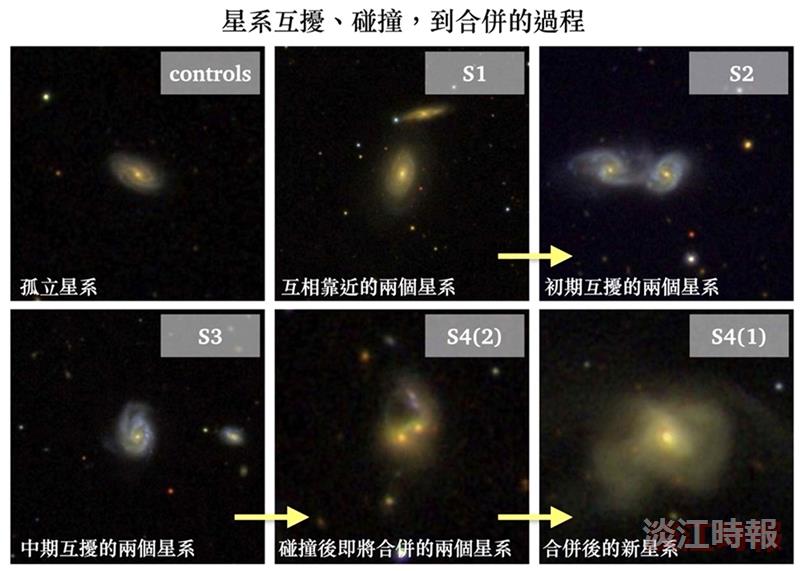News and Events
【Department Spotlight】Physics Faculty Hung-Chung Hsueh and Hsi-An Pan Publish Research in Leading International Journal
Date 2025-04-20 33 Clicks

Faculty members from Tamkang University's Department of Physics have recently published 2 major research papers in leading international journals.
Professor Hung-Chung Hsueh, together with Chih-En Hsu, a second-year Ph.D. student in Applied Science, and Yung-Ning Hsu, a second-year master's student in Physics, published their paper "Efficient light upconversion via resonant exciton-exciton annihilation of dark excitons in few-layer transition metal dichalcogenides" in Nature Communications (Impact Factor: 14.7) in March. This journal is considered one of the most important for reporting significant scientific discoveries. Meanwhile, Assistant Professor Hsi-An Pan served as first author for the paper "SDSS-IV MaNGA: Spatial Evolution of Gas-phase Metallicity Changes Induced by Galaxy Interactions," published on April 2 in The Astrophysical Journal. Department Chair Cheng-Hao Chuang noted that The Astrophysical Journal has been published for over 30 years as a leading Q1 journal in astronomy with an Impact Factor of 4.8 in 2023 and emphasized that these achievements highlight the department’s growing strengths in both theoretical and observational research.
Hung-Chung Hsueh explained that their study explored the electronic excitation properties of transition metal dichalcogenides (TMDs). The research team focused on the electronic and optical properties of nano-materials like TMDs, which hold great potential for next-generation optoelectronic and quantum devices. The team successfully predicted changes in electronic interactions and energy band structures under excited states, offering theoretical support for future material design and semiconductor development. Hsueh emphasized that the results demonstrate Tamkang University’s strong competitiveness in computational physics and quantum materials, and that the department will continue providing opportunities for students to engage in cutting-edge research.
Hsueh expressed deep gratitude for the collaboration with two outstanding domestic teams: experimental scientist Dr. Shao-Yu Chen from the Center for Condensed Matter Sciences at National Taiwan University, and theoretical scientist Professor Shun-Jen Cheng, Chair of the Department of Electrophysics at National Yang Ming Chiao Tung University. This close collaboration between theoretical predictions and advanced experimental measurements enabled more profound insights into the excited-state physical behavior of materials under extreme conditions. Yung-Ning Hsu, the third author and a second-year master's student in physics, was responsible for the theoretical calculations of excited-state band structures and analysis of electronic composition. It was her first experience collaborating with experimentalists on a research project. "It was truly an honor to be part of this collaboration and to publish in an international journal," she said. "I sincerely thank Professor Hsueh and all the team members who contributed to completing this work. I also hope this experience will inspire younger students to pursue research opportunities."
Meanwhile, Hsi-An Pan’s paper analyzed the phenomenon of galaxy collisions, investigating how gas and metallic elements flow and evolve when galaxies approach or merge. The research used data from the large astronomical survey project MaNGA (Mapping Nearby Galaxies at Apache Point Observatory), which conducted detailed observations of hundreds of nearby galaxies. Results showed that gas inflows of lower metallicity into galactic centers caused a temporary dilution of metal content, followed by a metallicity rebound as newly formed stars released fresh metals. "This research further illustrates the diversity and complexity of galaxy evolution, offering important insights into the formation and development of the universe," Pan concluded.
SDGs #SDG04 Quality Education #SDG09 Industry, Innovation and Infrastructure #SDG17 Partnerships for the Goals

Assistant Professor Hsi-An Pan from the Department of Physics published a paper in The Astrophysical Journal, presenting the processes of galactic interaction, collision, and merger.

Professor Hung-Chung Hsueh from the Department of Physics, Ph.D. student in Applied Science, Chih-En Hsu, and second-year Physics master's student Yung-Ning Hsu, published a research paper in Nature Communications.
LINKS
- PREV:【Department Spotlight】4 Architecture Alumni Admitted to Columbia University’s Graduate School of Architecture Through Perseverance 2025-04-18
- NEXT:Ping-Cheng Yeh Urges Students to Embrace 4 Workplace Traits to Find Their Place in a Changing Environment 2025-04-21
- Ping-Cheng Yeh Urges Students to Embrace 4 Workplace Traits to Find Their Place in a Changing Environment 2025-04-21
- 【Department Spotlight】Physics Faculty Hung-Chung Hsueh and Hsi-An Pan Publish Research in Leading International Journal 2025-04-20
- 【Department Spotlight】4 Architecture Alumni Admitted to Columbia University’s Graduate School of Architecture Through Perseverance 2025-04-18
- Tamkang University Commissioned by the Ministry of Education Again to Assist Universities in Improving Energy Efficiency Measures 2025-04-17
- Interpreting Plague Deities in East and West: Paul Katz Highlights How Religious Rituals Soothe the Human Spirit 2025-04-14
- 300 Indonesian Students Gather at Tamkang for Sports Olympics to Promote Intercollegiate Exchange 2025-04-13
- Taiwan’s Only Private University: Aerospace Engineering Department Launches Lunar Exploration Project 2025-04-11
- Dr. Sohail Inayatullah Featured in University World News Interview, Praises Tamkang’s Strength in Futures Studies 2025-04-10
- 4 Student Clubs Shine in Annual Evaluation; Robotics and Wind Ensemble Clubs Win Top Honors Again 2025-04-09
- International Students' Ecological and Cultural Exhibition Showcases Diverse Cultures and Sustainability Action 2025-03-31